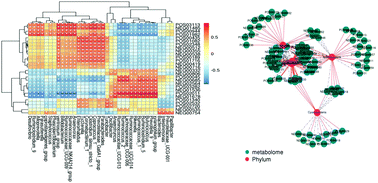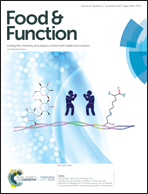Effects of theabrownin on serum metabolites and gut microbiome in rats with a high-sugar diet
Abstract
Evidence has proven that the gut microbiota is an important environmental factor contributing to obesity by altering host energy harvest and storage. We performed a high-throughput 16S rDNA sequencing association study and serum metabolomics profiling in rats with a high-sugar diet. Our studies revealed that the high sugar diet reduced the diversity of cecal microorganisms, while the combination of theabrownin and the high sugar diet increased the diversity of cecal microorganisms and promoted reproduction of Alloprevotella, Coprostanoligenes_group, Bacteroides, Prevotellaceae_NK3B31_group, Desulfovibrio, Intestinimonas, Alistipes, Bifidobacterium, Phascolarctobacterium, Ruminococcaceae_UCG-010 and Staphylococcus. The combination also inhibited the growth of Lactobacillus, Prevotellaceae_Ga6A1_group and Tyzzerella. The Firmicutes/Bacteroidetes (F/B) ratio can be significantly reduced after the intervention of theabrownin in high sugar diet rats, and the reproduction of Bacteroides acidifaciens (BA) and Staphylococcus saprophyticus subsp. saprophyticus can be promoted. We found that the obesity-associated gut microbial species were linked to the changes in circulating metabolites. Serum levels of deoxycholic acid, cholic acid, 1H-indole-3-acetic acid, 3-indole acrylic acid and melatonin were negatively correlated with BA and Staphylococcus saprophyticus subsp. saprophyticus, but positively correlated with Lactobacillus murinus, Leptum and Gut_metagenome. 2-Hydroxy-6-methylpyridin-3-carboxylic acid, L-homoserine, and 1,7-dimethylxanthine were positively correlated with BA and Staphylococcus saprophyticus subsp. saprophyticus, but negatively correlated with Lactobacillus murinus, Leptum, and Gut_metagenome. In a high sugar diet mode, theabrownin reduced the body weight and triglycerides and improved insulin resistance mainly by targeting the reproduction of intestinal microorganisms such as BA, Staphylococcus saprophyticus subsp. saprophyticus, Lactobacillus murinus, Leptum, Gut_metagenome and so on. A strong correlation between cecal microorganisms and serum metabolites, obesity and insulin resistance was observed. Theabrownin has high potential in reducing the risk of cardiovascular diseases such as diabetes and obesity.



 Please wait while we load your content...
Please wait while we load your content...